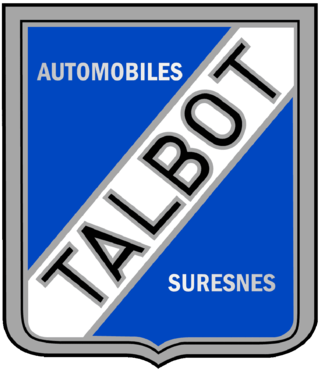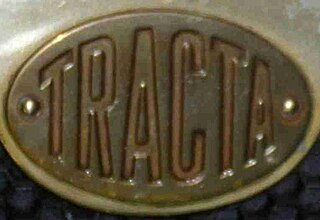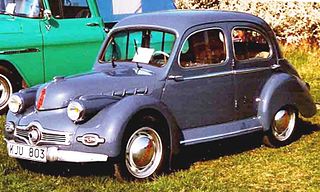
Mathis S.A. was an automobile manufacturer in Alsace that produced cars between 1910 and 1950. Founder Émile Mathis (1880–1956) was born in Strasbourg and died in Geneva.

Unic was a French manufacturer founded in 1905, and active as an automobile producer until July 1938. After this the company continued to produce commercial vehicles, retaining its independence for a further fourteen years before being purchased in 1952 by Henri Pigozzi, who was keen to develop Unic as a commercial vehicle arm of the then flourishing Simca business.

Talbot-Lago was a French automobile manufacturer based in Suresnes, Hauts de Seine, outside Paris. The company was owned and managed by Antonio Lago, an Italian engineer that acquired rights to the Talbot brand name after the demise of Darracq London's subsidiary Automobiles Talbot France in 1936.

Delage is a French luxury automobile and racecar company founded in 1905 by Louis Delâge in Levallois-Perret near Paris; it was acquired by Delahaye in 1935 and ceased operation in 1953.

The Peugeot 203 is a small family car which was produced by the French car manufacturer Peugeot between 1948 and 1960.

The Renault Juvaquatre is a small family car / compact car automobile produced by the French manufacturer Renault between 1937 and 1960, although production stopped or slowed to a trickle during the war years. The Juvaquatre was produced as a sedan/saloon until 1948 when the plant switched its full attention to the new Renault 4CV. During the second half of 1952 the plant restarted production of the Juvaquatre sedans/saloons for a period of approximately five months.

The Georges Irat was a French automobile manufactured by engine builder Georges Irat from 1921 to 1953.
Rovin was a French auto-maker established in the Paris region, and most active from 1946 until 1959, although after 1953 production slowed to a trickle. The firm was established, initially as a motor-cycle business, in 1921 by the racing driver and motorcycle constructor, Raoul Pegulu, Marquis of Rovin. The car was developed by Raoul but in 1946 production became the responsibility of his brother, Robert who continued to run the business after Raoul's death.

Tracta was a French car maker based in Asnières, Seine, that was active between 1926 and 1934. They were pioneers of front-wheel-drive vehicles.

The Panhard Dyna X was a lightweight berline produced by the French manufacturer Panhard from 1948 to 1954. It was designed by the engineer Jean Albert Grégoire and first exhibited as the AFG (Aluminium Français Grégoire) Dyna at the Paris Motor Show in October 1946.

Charron was a French automobile manufacturer, based in the Paris conurbation, and active between 1906 and 1930.
Lambert was a French automobile manufacturer established by Germain Lambert in 1926 at Mâcon. In commercial terms, it never progressed beyond marginal viability and it withdrew from auto-making towards the end of 1953.

Marathon was a French automobile manufacturer established by a group of engineers under the leadership of a rally enthusiast called Bernard Denis. Prototypes for a lightweight sports coupé were presented at various motor shows starting with the 1951 Frankfurt Motor Show and the cars were produced between 1953 and 1955.

Georges Mochet began to produce cycle-cars at his, now-demolished, premises at 68, Rue Roque-de-Fillol at Puteaux in approximately 1946 and by about 1952 had progressed to more modern looking two seater micro-cars and powered two-wheelers. In 1958, with approximately 3,000 vehicles manufactured, production ended.
Bernardet is the name of a manufacturing company created by three brothers named René, Robert and Roger Bernardet.
Boitel is a former French automaker.
Claveau is a former French automaker. The company began manufacturing cars in Paris in 1923. By 1956, the company had ceased production. Émile Claveau was recognized more as an innovator of experimental and sometimes inspirational engine designs rather than as a manufacturer of cars for sale.
Julien is a former French automobile manufacturer. The Paris based Société des Études Automobiles M. A. Julien presented its first prototype in 1946 and automaking activities came to an end in 1949, probably without any of the developments having progressed beyond the prototype stage.

Majola was a French producer of engines and automobiles, established in 1908 and producing automobiles from 1911 till 1928.

The Renault Vivasport was a 6-cylinder engined executive automobile introduced by Renault in September 1933 and produced till April 1935. A larger engined version was produced between December 1934 and February 1938. As with many Renaults during the 1930s, type changes as well as small often cosmetic facelifts and upgrades appeared frequently.